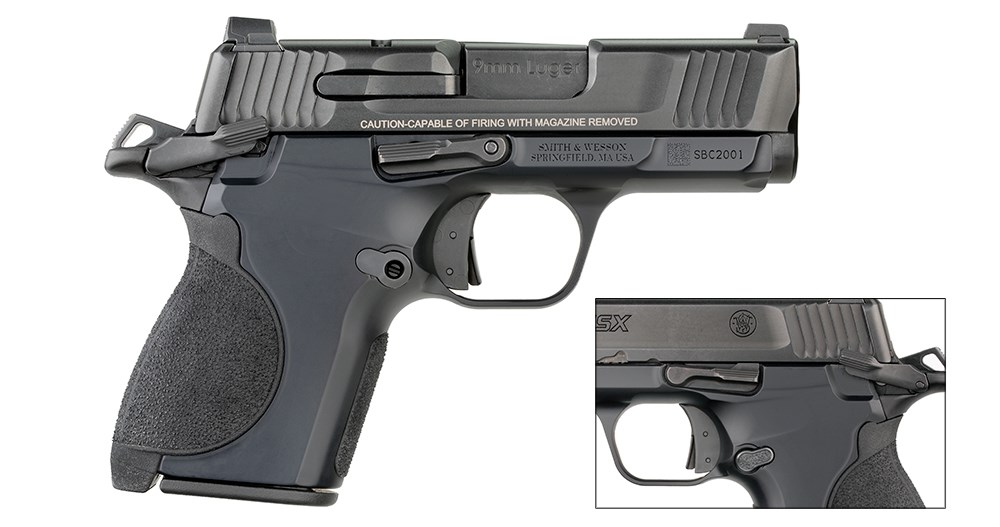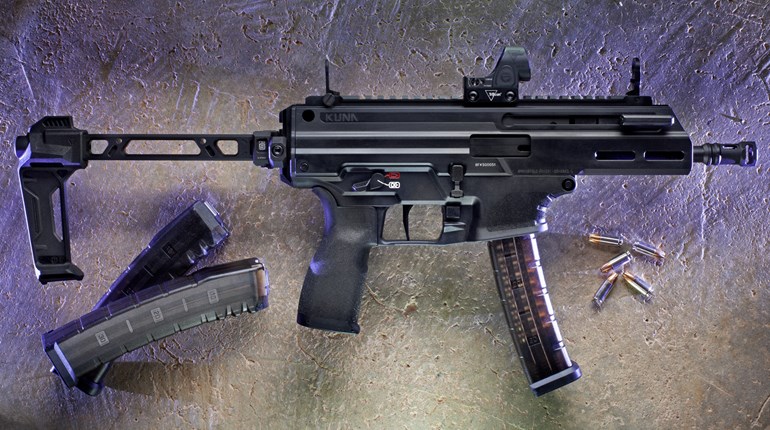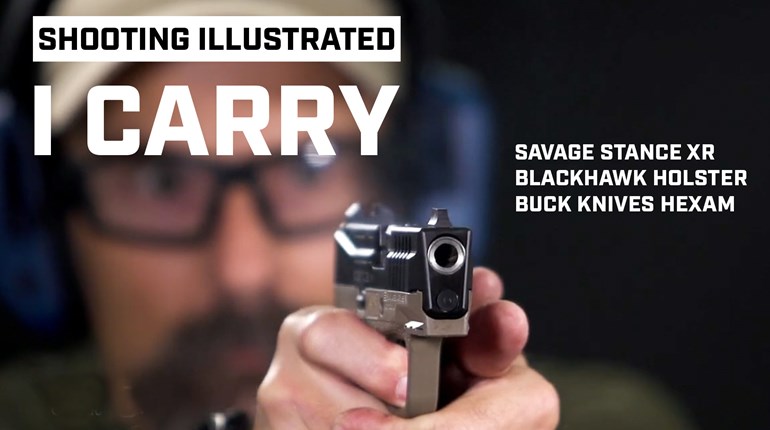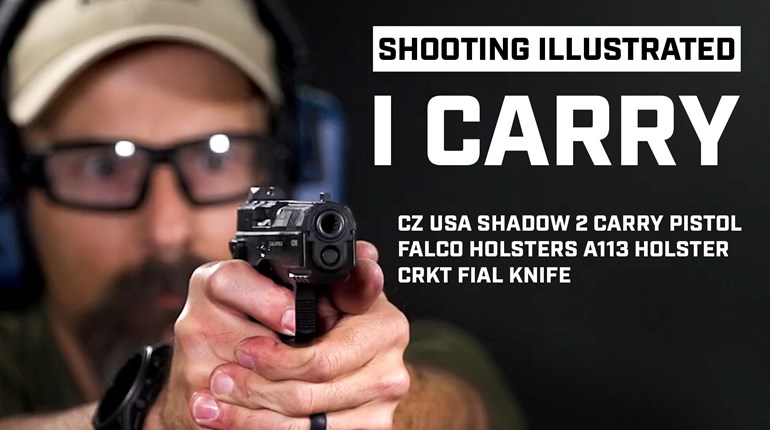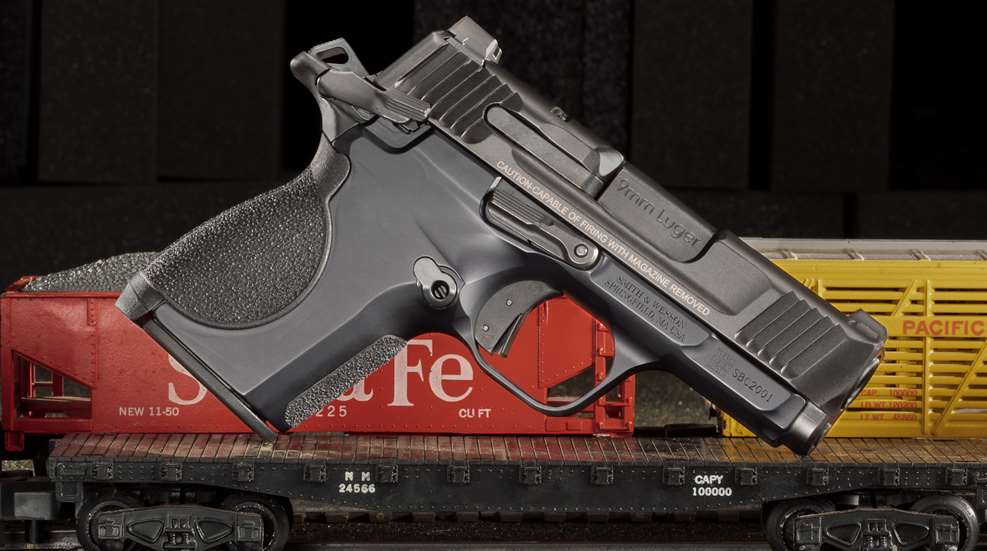
I’m not going to lie; when I saw the press release from Smith & Wesson about its new CSX pistol, I was skeptical. At a time when the polymer-frame, striker-fired, micro-9 mm double-stack pistol was conquering the landscape, Smith & Wesson launched the CSX, a metal-frame, single-action-only handgun. Heck, even trying to describe the CSX is on the complicated side. It’s kinda, sorta like a 1911; kinda, sorta similar to the Hi Power, and, then again, neither of those.
Closer inspection, though, and the CSX isn’t as much of an oddball as it first might seem. In fact, it’s rather ingenious. There’s a market for vaguely-1911-ish, concealable handguns that started with the Colt Mustang/Government 380 in the 1980s. This trend continued with the SIG Sauer P238 (.380 ACP) and P938 (9 mm), the 911 in both .380 ACP and 9 mm from Springfield Armory and Kimber’s Micro (.380 ACP) and Micro9. All of a sudden, the CSX isn’t looking as much the odd gun out as before, is it?
Then you realize, wait a minute … The CSX starts with a 10-round magazine, and has a 12-round, slightly extended variant available. Hold the phone. It’s now competitive, capacity-wise, with the P365, Hellcat, et al, while maintaining a single-action-operating system, which is one of the most prominent features mentioned in support of the 1911. Smith & Wesson has, with its CSX, carefully blended the worlds of the 1911/Hi Power with the micro-9 mm double-stack handgun. That’s basically sorcery. Well, at least very clever engineering.
There’s no sorcery in the name, though. It’s clear Smith & Wesson was reaching back in its long history for the “CS” part of “CSX,” a nod to the “Chiefs Special” line of five-shot, small-frame revolvers launched in the 1950s as a backup gun to the larger K- and N-frame pistols of the day. The “CS” designation would be added to a short-lived line of double-action, semi-automatic pistols in the late 1990s, again aimed squarely at the growing concealed-carry market. With the advent of the M&P line of polymer-frame, striker-fired handguns in the mid-2000s, the CS line made way for subcompact M&Ps. Until now, that is. The “X” in “CSX?” Smith & Wesson tells us it stands for the intersection of the company’s past and future. I like that.
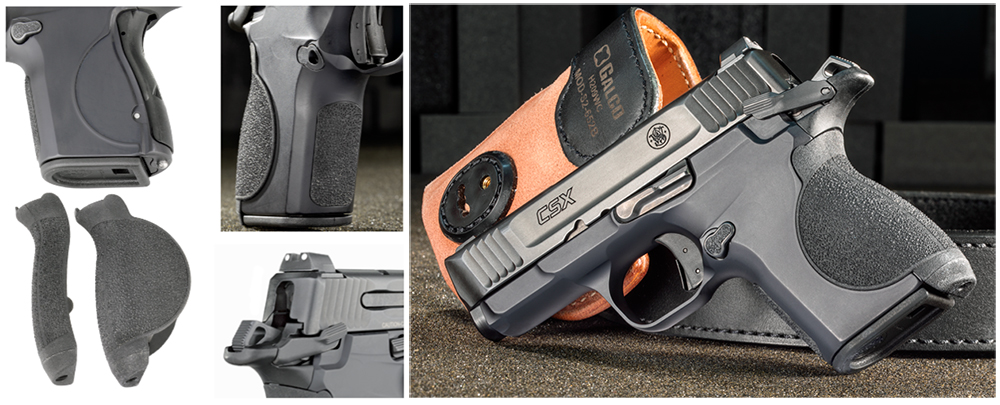
Dave O’Connor, Smith & Wesson’s media-partnership relations manager, explained it simply: “CSX is 100 percent a nod to our ‘Chiefs Special’ heritage. Smith & Wesson has such a robust history with metal-frame handguns, and because of that we wanted to pay homage to our past. The CSX was built on some of our history, but we really tried to incorporate modern features that the consumer of today is looking for—higher capacity, caliber choice, interchangeable palmswells, etc.”
Still not convinced about the CSX, though? Let’s run the numbers. Compare the CSX to its sibling, the Shield Plus. Overall length? Identical. Height? Identical. Barrel length? Identical. Capacity? Identical. The CSX is wider than the Shield Plus—by a whopping .02 inch. I don’t know about anyone else, but I can’t tell the difference between a pistol that’s 1.1 inches wide and one that’s 1.12 inches wide. The only significant difference between the CSX and the Shield Plus is the weight, and here’s where things get interesting: The metal-frame CSX is .7 ounce lighter. Basically, the CSX and the Shield Plus are indistinguishable in all dimensions. Since the Shield Plus is pretty middle-of-the-pack, size-wise, in the micro-9 mm double-stack world, it’s the same for the CSX.
It’s the similarity in size and capacity to the Shield Plus that leads to a natural question: Why? Why would Smith & Wesson devote time, research and development and effort into producing a micro-9 mm, double-stack, concealed-carry pistol immediately on the heels of introducing the Shield Plus? Pro- duct Manager Corey Beaudreau stated it simply: “Smith & Wesson launched the CSX to provide today’s firearm enthusiast with more options to answer the question of concealed carry. Not everyone prefers striker-fired, polymer [-frame] micro-9 mm [pistols], so we wanted to still deliver the higher capacity in a small, metal frame, but with some improvements from a micro 1911.”
There is one unfortunate difference between the Shield Plus and the CSX, though: the magazines. While both pistols have a flush-fit, 10-round magazine and a slightly extended, 12-round magazine available, the two are not interchangeable. Per Smith & Wesson, the quest to provide the smallest, most concealable hammer-fired pistol required a completely new magazine geometry that would not allow cross-compatibility. It’s not a deal-breaker by any stretch of the imagination, but it something about which to be aware.
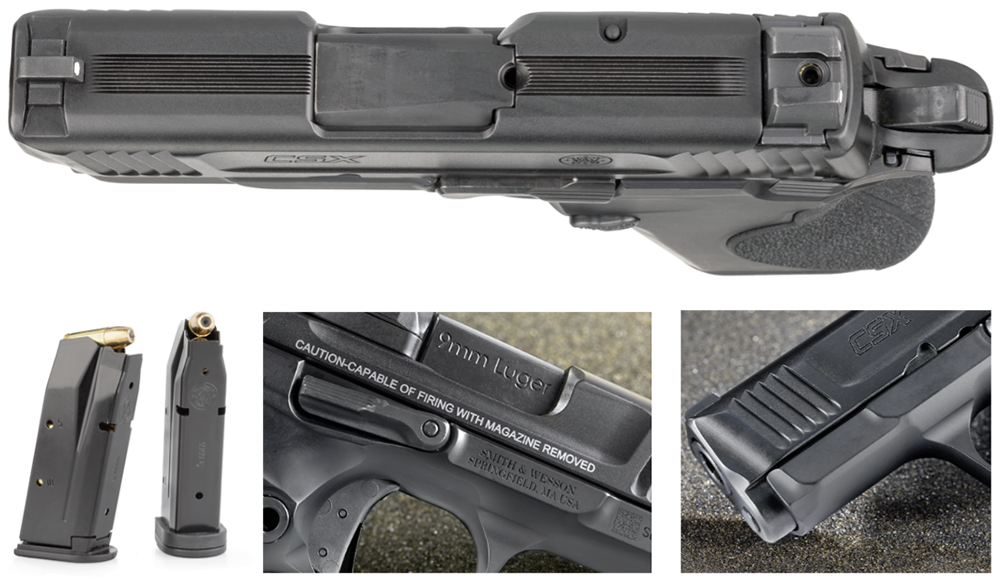
In its quest for that diminutive, hammer-fired pistol, Smith & Wesson crammed an absolute ton of clever engineering into the CSX. Intended to be carried “cocked and locked” like a 1911 or Hi Power, it has a thumb safety like both pistols. It also has a trigger-based safety like most striker-fired guns to guard against discharging if dropped or struck—something other, similarly designed pistols often lack. Oh, and did I mention the interchangeable backstraps? Two sizes are available to better fit the CSX to the shooter’s hand. And talk about ambidextrous: The thumb safety and slide-stop lever are both completely ambidextrous, while both left- and right-side magazine releases are included to make the CSX as friendly as possible for all shooters.
Other smart design features include the textured frontstrap of the pistol. While recoil isn’t terribly significant, it’s nice to have the moderately aggressive texturing of the M2.0 M&P design incorporated into the CSX frontstrap and interchangeable backstraps. The trigger has a flat-face with an integrated safety mechanism, consistent with the latest round of M2.0 upgrades on the M&P line as well. It’s easy to see where the modern aspect of the CSX comes in, here. Up on top, the CSX has dovetail-mounted front- and rear sights, with the familiar three-white-dot arrangement. The top of the slide is serrated to reduce glare, a nice touch; as are the cocking serrations, front and rear, with a pronounced edge at the rear to assist in charging the pistol.
In its takedown, the CSX is more like a standard, striker-fired pistol than a 1911. Standard caveats apply, of course: Make sure no ammunition is present, remove the magazine, check the chamber manually and visually, etc. Lock the slide to the rear with the thumb safety engaged, then drift a small pin out in the slide-stop lever, right-to-left, after aligning the lever with the takedown notch. The pin falls out, attached to the left-side slide-stop lever, and then the slide can be taken off the frame. Remove the guide rod with captured recoil spring, then tilt the barrel up and out of the slide. To reassemble, complete the steps in reverse. There’s no need to pull the trigger as part of the disassembly process, which some find reassuring.
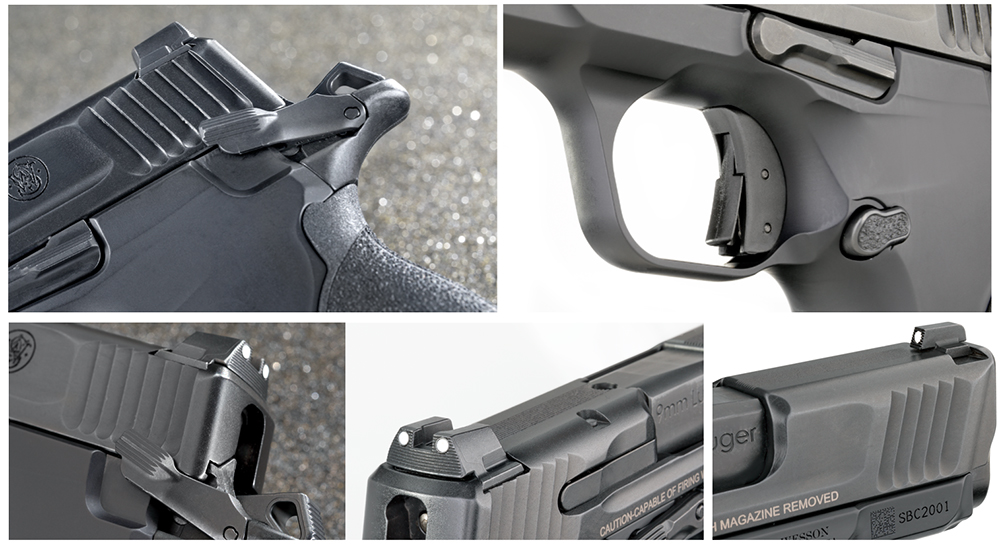
I had the opportunity to shoot the CSX at a pre-SHOT Show event sponsored by Smith & Wesson in Las Vegas. Whether it was a paper target at 10 yards or a rack of hanging (polymer) plates, the CSX performed spectacularly. Working the pistol from plate to plate, the trigger’s short reset made even my mediocre shooting look good. Some reviews mentioned problems with the reset, but I’ve tested three separate CSX pistols and haven’t had any issues with the trigger. I’ve never been a fan of the bladed-safety lever on triggers in general as a tactile thing, and I’m still not 100-percent sold on this version of Smith & Wesson’s trigger on the M&P line as it is, but the trigger on the CSX has been one of the better versions I’ve tried.
When it comes to carrying the CSX, well, if you’re comfortable carrying the Shield, you’ll be fine with the CSX. Since the CSX is the same size as the Shield Plus, which is only a tiny bit wider in the slide than the original Shield, it shouldn’t present any unusual difficulties for inside-the-waistband carry. While in certain pants with larger pockets it’s possible to pocket-carry the CSX, the advisability of carrying a single-action pistol in this manner varies from person to person. It certainly can be done, and there’s nothing inherently unsafe as long as a quality holster is used and nothing other than pistol and holster are in the pocket.
On the range, absolutely no surprises were to be had with the CSX, although there was something of which to take note. I tend to keep a high (very high) grip on a pistol, and with only medium-size hands found the bottom left edge of the slide to graze the top of the bottom knuckle on my thumb. I’ve had this happen before, mostly on similar-size pistols, and with the CSX it wasn’t bad. After I’d fired approximately 300 rounds, I had a slight blister. On other pistols, it has been so bad that it hindered operation of the slide. Not a deal-breaker, but something to watch for, especially if you’re planning on taking a high-round-count training class. Might be a good idea to bring some gloves.
The accuracy surprised me, although I guess I really should have expected it given the single-action trigger. The CSX has exactly the same length barrel as the Shield Plus I reviewed in August, 2022, and is chambered in 9 mm rather than the lighter-recoiling 30 Super Carry of the Shield Plus; however, I shot more accurately with the CSX. Again, it’s a very pleasant surprise, and it’s not entirely unpredictable given the trigger, but it was quite interesting to note. 
Our Handgun Editor, also in the August 2022, issue, pointed out that defining a trigger is difficult, and often results in the trigger-pull weight being given as a be-all, end-all number. For the CSX, that’s especially true: While the 5 pound, 12 ounce weight of the trigger is right in line with that of many striker-fired pistols, there’s far less travel and zero mush, resulting in a supremely clean break. For a small gun, it shoots well. Heck, even were it a large gun, it shoots well.
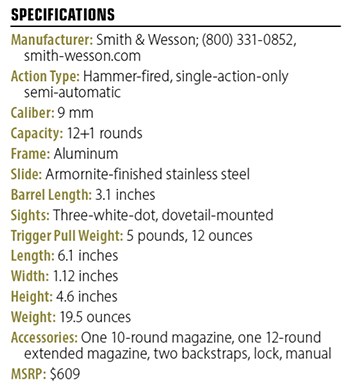 Over the course of testing the CSX, I put somewhere between 450 and 500 rounds through three different pistols, between the initial launch, featuring the CSX in an episode of our “I Carry” online video series and the standard testing we do for each firearm we review (accuracy, velocity and function testing). No malfunctions of any type were experienced over a wide variety of both defensive and practice ammunition. There comes a point where you realize that there’s not much more to say other than it works. Period. Full stop.
Over the course of testing the CSX, I put somewhere between 450 and 500 rounds through three different pistols, between the initial launch, featuring the CSX in an episode of our “I Carry” online video series and the standard testing we do for each firearm we review (accuracy, velocity and function testing). No malfunctions of any type were experienced over a wide variety of both defensive and practice ammunition. There comes a point where you realize that there’s not much more to say other than it works. Period. Full stop.
Smith & Wesson considers the CSX to be a completely new product line, so the future almost certainly will see line expansions and upgrades. It wouldn’t be the least bit surprising to see an optics-ready version, or perhaps one chambered in 30 Super Carry in the near future, although there are no concrete plans at the moment. Six months from now, though? There are all kinds of directions the CSX line could take, and as I’m fond of saying in our “I Carry” videos, more options are a good thing. Personally, I’m hoping for an optics-ready version. In any case, the CSX has respectable capacity, eminent shootability and Smith & Wesson’s legendary reliability in its corner.
With all this, what’s the bottom line on Smith & Wesson’s new CSX pistol? Well, it’s good to see a company thinking beyond mere line extensions. Smith & Wesson certainly took a chance with the CSX, offering an all-metal pistol with a single-action-only operating system at a time when everyone and their brother seems to be launching polymer-frame, striker-fired micro-9 mm, double-stack, optics-ready pistols. The CSX still checks all the right boxes in capacity, weight and size, so it’s an excellent choice for concealed carry, particularly for those who prefer other-than-striker-fired pistols. It works well, it shoots well and it carries well. I think it’s a no-brainer to say that Smith & Wesson is on the right track with the CSX.